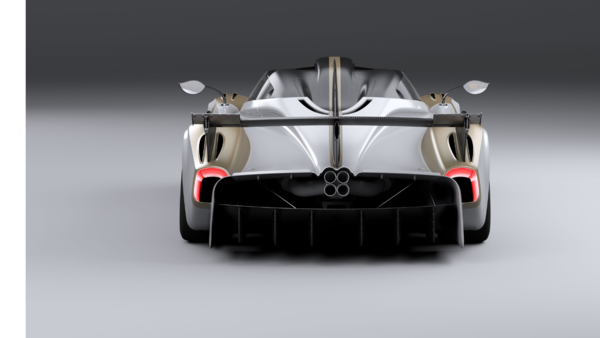Pagani Huayra R Evo- The Thrilling Car-24
Pagani Huayra R Evo
The Huayra R Evolution
Pagani is contesting the widely held belief that a track car must be a coupe. It unveiled the Evo, a long-tail version of the Huayra R with a 900 horsepower V12 engine, 45% more downforce than the car it is based on, and two detachable roof panels.
The brand clarifies that it took influence from other sources, such as vintage Le Mans cars and IndyCar drivers. “Let’s start by removing the roof and take it from there,” company founder Horacio Pagani continues.

In addition to the modification of the rear diffuser and rear lights, the body is composed of carbon fiber.
About aerodynamic Pagani Huayra R Evo
The aerodynamic profile of the Pagani Huayra R Evo has been redesigned to boost downforce and efficiency without increasing air resistance, by 45% and 21%, respectively, over the basic R. To put it another way, the Evo produces a higher vertical aerodynamic load than its overall weight when travelling at 199 mph.
Moreover, the open roof panel surprisingly improves aerodynamic efficiency by contributing to a 5% increase in downforce rather than a 1% increase in drag. A set of roof panels easily converts the Huayra R Evo into a coupe if you’d prefer not to use a hyper car as your hair dryer.
Follow Our Digiknowledge.co.in Page for Latest update about Bikes, Cars, Sports, , Life style and many more.
Sequential gearbox for Pagani Huayra R Evo
The six-speed sequential gearbox that Pagani and HWA AG created together for their Huayra race vehicles is located between the engine and the back wheels. Merely 176 pounds is the weight of the non-synchronized dog ring gearbox.

Power of Pagani Huayra R Evo
The 6.0-liter V12 engine, which debuted with the Huayra R, has evolved into the Evo model, which provides power. With its redline set at 9,200 rpm, it produces 568 pound-feet of torque between 5,800 and 8,200 rpm and 900 horsepower at 8,750 rpm in this application. With a new intake manifold, camshafts, and an exhaust system tuned to provide a unique sound, the naturally aspirated engine has new features.
The six-speed sequential gearbox that powers the cavalry’s rear wheels is structurally incorporated into the suspension setup.
Unique suspension of Pagani Huayra R Evo
The suspension was significantly altered by Pagani, who included a heave damper, which he defined as “a third hydraulic element that separates the management of the car-body height from the independent dampers of the four wheels.” Along with bigger Pirelli P Zero tyres than the Huayra R’s, Brembo and an upgraded carbon-ceramic brake system designed specifically for the Evo were installed.
Given that Pagani asserts the Evo can equal the performance of a Le Mans Prototype 2 race car, the entire package ought to be even more amazing in practice than it is in theory.
The cost has not yet been disclosed, but this is one of those “if you need to ask…” situations. Although production numbers haven’t been disclosed either, purchasers will be qualified to take part in non-competitive car driving events on tracks across the globe under the Arte in Pista programme.
The technical director, engineers, and mechanics from Pagani’s internal support staff provide them with help.
More about Pagani Huayra R Evo
The vehicle’s electronically regulated shock absorbers, helical springs, and forged aluminium alloy double-wishbone suspension keep everything comfy. Its handling abilities is further improved by a new heave damper.
With Pirelli P Zero Slick tyres measuring 280/680 R19 up front and 345/725 R20 down back, the vehicle can reach a top speed of 218 miles per hour. The CCM-R self-ventilated carbon ceramic brakes and custom racing pads provide stopping force.
By extending the front splitter by around four inches, Pagani has given the Huayra R Evo the “codalunga” (long-tail) treatment. This extends and integrates the cooling system ducting. Its rear wing is supported by an integrated support system and a redesigned center stabilizing fin, making it approximately 7.5 inches longer.
The modified layout increases downforce by 45%, and the increased front and rear vertical loads in the open-top version provide an additional 5% to the total downforce. The downforce produced by the Huayra R Evo surpasses its operating weight at 199 mph. Approximately 150 pounds less than a new Miata, it weighs 2,337 pounds dry.
Six-point harnesses and carbon-fiber headrests with specific lateral protection are included in the Interior of the fireproof material-covered seats by Pagani. Both left- and right-hand drives can be configured on Pagani.
After seeing a Formula Indy race in Nashville, Horacio Pagani came up with the concept for the open-top Evo. Pagani claims the vehicle, which took almost two years to build, can compete on a par with the current generation of Le Mans Prototype 2 race cars. We can only hope that the fortunate few will test that claim with their autos.
Why is the Pagani Huayra so expensive?
Pagani produces a small number of cars each year, and each car is handmade for the client. Carbon fibre is used in the chassis and body panels of Pagani automobiles, which are manufactured in Italy using premium materials. Expensive and uncommon materials are used to construct the car’s parts, like the forged aluminium alloy APP monolithic wheels.
What is the most expensive supercar?
The Rolls-Royce La Rose Noire Droptail, which retails for more than $30 million, is the most costly vehicle in the world as of August 2023.
Which is the world costly car No 1?
Which is the world costly car No 1?
Rolls Royce Boat Tail. ₹233.28 crores Price ($1= ₹83.16, as of January 29, 2024)




